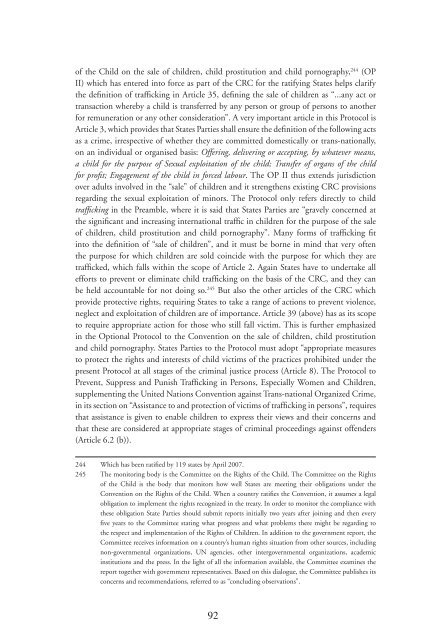Trafficking in human beings: human rights and ... - unesdoc - Unesco
Trafficking in human beings: human rights and ... - unesdoc - Unesco
Trafficking in human beings: human rights and ... - unesdoc - Unesco
Create successful ePaper yourself
Turn your PDF publications into a flip-book with our unique Google optimized e-Paper software.
of the Child on the sale of children, child prostitution <strong>and</strong> child pornography, 244 (OP<br />
II) which has entered <strong>in</strong>to force as part of the CRC for the ratify<strong>in</strong>g States helps clarify<br />
the defi nition of traffi ck<strong>in</strong>g <strong>in</strong> Article 35, defi n<strong>in</strong>g the sale of children as “...any act or<br />
transaction whereby a child is transferred by any person or group of persons to another<br />
for remuneration or any other consideration”. A very important article <strong>in</strong> this Pro tocol is<br />
Article 3, which provides that States Parties shall ensure the defi nition of the follow<strong>in</strong>g acts<br />
as a crime, irrespective of whether they are committed domestically or trans-nationally,<br />
on an <strong>in</strong>dividual or organised basis: Offer<strong>in</strong>g, deliver<strong>in</strong>g or accept<strong>in</strong>g, by whatever means,<br />
a child for the purpose of Sexual exploitation of the child; Transfer of organs of the child<br />
for profi t; Engagement of the child <strong>in</strong> forced labour. The OP II thus extends jurisdiction<br />
over adults <strong>in</strong>volved <strong>in</strong> the “sale” of children <strong>and</strong> it strengthens exist<strong>in</strong>g CRC provisions<br />
regard<strong>in</strong>g the sexual exploitation of m<strong>in</strong>ors. The Protocol only refers directly to child<br />
traffi ck<strong>in</strong>g <strong>in</strong> the Preamble, where it is said that States Parties are “gravely concerned at<br />
the signifi cant <strong>and</strong> <strong>in</strong>creas<strong>in</strong>g <strong>in</strong>ternational traffi c <strong>in</strong> children for the purpose of the sale<br />
of children, child prostitution <strong>and</strong> child por nography”. Many forms of traffi ck<strong>in</strong>g fi t<br />
<strong>in</strong>to the defi nition of “sale of children”, <strong>and</strong> it must be borne <strong>in</strong> m<strong>in</strong>d that very often<br />
the purpose for which children are sold co<strong>in</strong>cide with the pur pose for which they are<br />
traffi cked, which falls with<strong>in</strong> the scope of Article 2. Aga<strong>in</strong> States have to undertake all<br />
efforts to prevent or elim<strong>in</strong>ate child traffi ck<strong>in</strong>g on the basis of the CRC, <strong>and</strong> they can<br />
be held accountable for not do<strong>in</strong>g so. 245 But also the other articles of the CRC which<br />
provide protective <strong>rights</strong>, requir<strong>in</strong>g States to take a range of actions to prevent violence,<br />
neglect <strong>and</strong> exploitation of children are of importance. Article 39 (above) has as its scope<br />
to require appropriate action for those who still fall victim. This is further emphasized<br />
<strong>in</strong> the Optional Protocol to the Convention on the sale of children, child prostitution<br />
<strong>and</strong> child pornography. States Parties to the Protocol must adopt “appropriate measures<br />
to protect the <strong>rights</strong> <strong>and</strong> <strong>in</strong>terests of child victims of the practices prohibited under the<br />
present Protocol at all stages of the crim<strong>in</strong>al justice process (Article 8). The Protocol to<br />
Prevent, Suppress <strong>and</strong> Punish Traffi ck<strong>in</strong>g <strong>in</strong> Persons, Especially Women <strong>and</strong> Children,<br />
supplement<strong>in</strong>g the United Nations Convention aga<strong>in</strong>st Trans-national Organized Crime,<br />
<strong>in</strong> its section on “Assistance to <strong>and</strong> protection of victims of traffi ck<strong>in</strong>g <strong>in</strong> persons”, requires<br />
that assistance is given to enable children to express their views <strong>and</strong> their concerns <strong>and</strong><br />
that these are considered at appropriate stages of crim<strong>in</strong>al proceed<strong>in</strong>gs aga<strong>in</strong>st offenders<br />
(Article 6.2 (b)).<br />
244 Which has been ratifi ed by 119 states by April 2007.<br />
245 The monitor<strong>in</strong>g body is the Committee on the Rights of the Child. The Committee on the Rights<br />
of the Child is the body that monitors how well States are meet<strong>in</strong>g their obligations under the<br />
Convention on the Rights of the Child. When a country ratifi es the Convention, it assumes a legal<br />
obligation to imple ment the <strong>rights</strong> recognized <strong>in</strong> the treaty. In order to monitor the compliance with<br />
these obligation State Parties should submit reports <strong>in</strong>itially two years after jo<strong>in</strong><strong>in</strong>g <strong>and</strong> then every<br />
fi ve years to the Committee stat<strong>in</strong>g what progress <strong>and</strong> what problems there might be regard<strong>in</strong>g to<br />
the respect <strong>and</strong> implementation of the Rights of Children. In addition to the government report, the<br />
Committee receives <strong>in</strong>formation on a country’s <strong>human</strong> <strong>rights</strong> situation from other sources, <strong>in</strong>clud<strong>in</strong>g<br />
non-governmental organizations, UN agencies, other <strong>in</strong>tergovernmen tal organizations, academic<br />
<strong>in</strong>stitutions <strong>and</strong> the press. In the light of all the <strong>in</strong>for mation available, the Committee exam<strong>in</strong>es the<br />
report together with government representatives. Based on this dialogue, the Committee publishes its<br />
concerns <strong>and</strong> recommendations, referred to as “conclud<strong>in</strong>g observations”.<br />
92

















